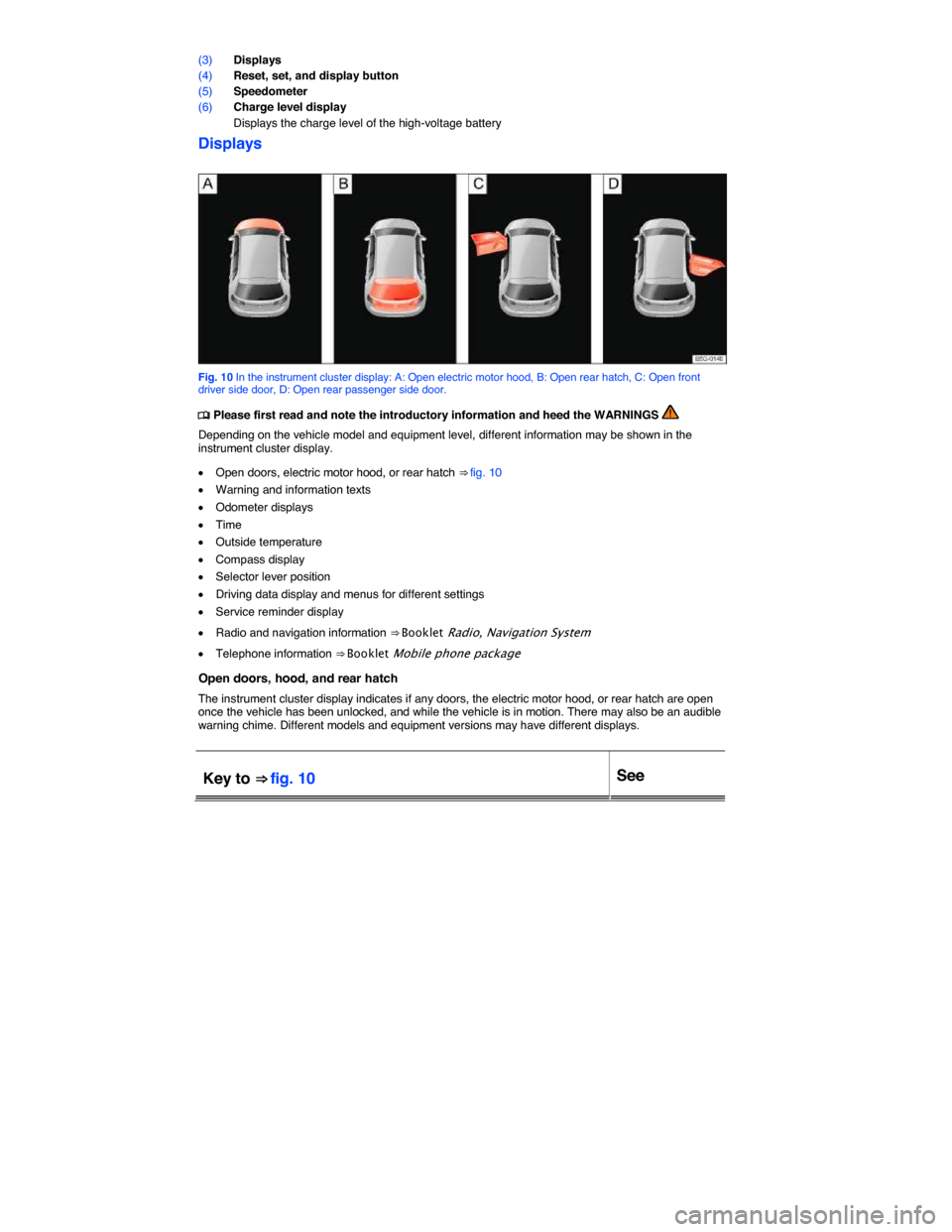2015 VOLKSWAGEN E GOLF reset
[x] Cancel search: resetPage 10 of 394

(3) Displays
(4) Reset, set, and display button
(5) Speedometer
(6) Charge level display
Displays the charge level of the high-voltage battery
Displays
Fig. 10 In the instrument cluster display: A: Open electric motor hood, B: Open rear hatch, C: Open front driver side door, D: Open rear passenger side door.
�
Page 12 of 394

Type of no-
tification
Symbol
color1
Explanation
Priority 2
warning
message
Yellow Symbol flashing or continuously lit – sometimes
with acoustic warnings.
Malfunctions or low operating fluid levels may
cause vehicle damage and vehicle breakdown
⇒ .
Check malfunction as soon as possible. Contact
an authorized Volkswagen dealer or an author-
ized Volkswagen Service Facility for assistance if
necessary.
Information
text
– Information about various vehicle situations.
Odometer displays
The odometer indicates the total distance driven by the vehicle.
The trip odometer (trip) shows the distance driven since the last time the trip odometer was reset. The last digit indicates 1/10 mile (100 meters).
Press the �E button in the instrument cluster briefly ⇒ Instrument overview to reset the trip odometer to 0.
Time
�x To set the time, press and hold the �E button in the instrument cluster ⇒ Instrument overview until the word Time appears in the display. The doors must be closed.
�x Release the button. The time is shown in the display and the hour setting is highlighted.
�x Press the �E button repeatedly until the correct hour is displayed. Press and hold the button to scroll through quickly.
�x Once you have set the hour, wait a few seconds until the minutes display is highlighted.
�x Press the �E button repeatedly until the correct minutes are displayed. Press and hold the button to scroll through quickly.
�x Release the button to finish setting the clock.
On appropriately equipped vehicles, you can also set the time in the Infotainment system by pressing
the �#�!�2 button followed by the �
Page 26 of 394

Menu Submenu Setting options See
– Reset the following
data in the Multifunc-
tion display:
– Driving data for
“Since start” trip
memory
– Driving data for
“Extended period”
trip memory
Time and date – Select and set the
following data:
– Clock time source
(manual, GPS)
– Time
– Daylight savings
time
– Time zone
– Time format (12
hour, 24 hour)
– Date
– Date format
–
Units – Set the units for the
following:
– Distance
– Speed
– Temperature
– Volume
– Consumption
– Pressure
–
Service – Display the following
data:
– Vehicle identifica-
tion number (VIN)
– Date of next in-
spection service
Page 27 of 394

Menu Submenu Setting options See
Factory set-
tings
– Reset the following
features:
– All settings
– Parking aids
– Lights
– Mirrors and wipers
– Open and close
– Multifunction dis-
play
–
Page 113 of 394

Coming
Home
Action
Switch off: – Automatically after delay period is over.
– Automatically, if a vehicle door or the rear hatch is still
open about 30 seconds after activation.
– Turn light switch to the �/ position.
– Switch the ignition on.
Leaving
Home Action
Switch on: – Unlock the vehicle if the light switch is in the �!�5�4�/ posi-
tion and the low-light sensor registers darkness.
Switch off: – Automatically after preset delay period is over.
– Lock the vehicle.
– Turn the light switch to the �/ position.
– Switch the ignition on.
The length of time the lights stay on can be adjusted or the feature can be activated and deac-tivated in the Infotainment system by pressing the �#�!�2 button followed by the �
Page 184 of 394

As an added safety feature, your vehicle has been equipped with a Tire Pressure Monitoring System (TPMS) that illuminates a low tire pressure telltale when one or more of your tires is significantly underinflated. Accordingly, when the low tire pressure telltale illuminates, you should stop and check your tires as soon as possible, and inflate them to the proper pressure. Driving on a significantly underinflated tire causes the tire to overheat and can lead to tire failure. Underinflation also reduces power efficiency and tire tread life, and may affect the vehicle’s handling and stopping ability.
Please note that the TPMS is not a substitute for proper tire maintenance, and it is the driver’s respon-sibility to maintain correct tire pressure, even if underinflation has not reached the level to trigger illumination of the TPMS low tire pressure telltale.
Your vehicle has also been equipped with a TPMS malfunction indicator to indicate when the system is not operating properly. The TPMS malfunction indicator is combined with the low tire pressure telltale. When the system detects a malfunction, the telltale will flash for approximately 1 minute and then remain continuously illuminated. This sequence will continue upon subsequent vehicle start-ups as long as the malfunction exists.
When the malfunction indicator is illuminated, the system may not be able to detect or signal low tire pressure as intended. TPMS malfunctions may occur for a variety of reasons, including the installation of replacement or alternate tires or wheels on the vehicle that prevent the TPMS from functioning properly. Always check the TPMS malfunction telltale after replacing one or more tires or wheels on your vehicle to ensure that the replacement or alternate tires and wheels allow the TPMS to continue to function properly.
Resetting and recalibrating the benchmark tire pressure
Resetting the tire pressures in the Infotainment system resets the benchmark tire pressure used by the TPMS to the current tire pressure in the tires based on the circumference of the tires.
�x Switch on the ignition.
�x Press the �#�!�2 Infotainment button ⇒ Menu and system settings (SETUP).
�x Tap the �
Page 260 of 394

Control module display ⇒ fig. 136:
No. Display Meaning Proper re-
sponse
(1) (2) (4) Lights up
During the
charging pro-
cess: The con-
trol unit detected
a residual cur-
rent, the charg-
ing process is
interrupted.
Dangerous con-
tact voltage
damaged isola-
tion detected at
the voltage
source. High-
voltage battery is
not being
charged.
Or: Damaged
isolation detect-
ed in the vehi-
cle’s high-
voltage system.
Get expert assis-
tance from a
qualified electri-
cal installation
specialist.
During the test-
ing of the
Ground Fault
Circuit (GFI):
The test button
(3) was pressed
for longer than 3
seconds. The
high-voltage
battery is not
being charged.
Press the reset
button (6) for at
least 3 seconds.
(1) (2) Flashes Charging cable Have charging
Page 317 of 394

should always be replaced by a qualified technician, since the vehicle's onboard electrical system management has to be reset after replacing the battery. Only a qualified service facility is able to perform this necessary adjustment. Therefore, Volkswagen recommends to always have the 12 volt vehicle battery replaced by an authorized Volkswagen dealer or an authorized Volkswagen Service Facility.
Only use maintenance-free vehicle batteries meeting standards TL 825 06 and VW 7 50 73. These standards must date from July 2012 or later.
Disconnecting the 12 Volt vehicle battery
If the battery must be disconnected from the vehicle's electrical system, note the following:
�x Switch off all electrical systems and devices and the ignition.
�x Unlock the vehicle before disconnecting the battery; otherwise the alarm system will go off.
�x First disconnect the negative cable (-) and then the positive cable (+) ⇒ .
Connecting the 12 volt vehicle battery
�x Prior to reconnecting the battery, switch off all electrical systems and devices and the ignition.
�x Connect the positive cable (+) first and then the negative cable (-) ⇒ .
After the battery is connected and the ignition is switched on, different indicator lights may light up. They should go out after you drive a short distance at 10–12 mph (15–20 km/h). If the indicator lights do not go out, contact an authorized Volkswagen dealer or an authorized Volkswagen Service Facility and have the vehicle checked.
If the battery was disconnected for a long time, the next scheduled service may not be correctly calcu-
lated and displayed ⇒ Instrument cluster. The maximum permissible service and maintenance inter-
vals are shown in the ⇒ Booklet Warranty and Maintenance.
Vehicles with Keyless Access
If the ignition will not start after reconnecting the vehicle battery, lock the vehicle from the outside and
unlock it again ⇒ Unlocking or locking the vehicle with Keyless Access. Then try to start the ignition again. If the ignition cannot be switched on, contact an authorized Volkswagen dealer, an authorized Volkswagen Service Facility, or another qualified workshop for assistance.
Automatic electrical load deactivation
If the vehicle battery drain is high, the intelligent onboard electrical system management automatically takes steps to help prevent battery drain.
�x The idle speed is increased so that the alternator provides more power.
�x The power to devices that consume a lot of electricity is cut back or switched off completely.
The onboard electrical system management cannot always keep the battery from being drained. For example, the battery will drain if the electric motor is not activated, but the ignition is switched on or the parking lights are left on for a long time when parked.
What drains the vehicle battery?
�x Long periods when the electric motor is not activated, especially when the ignition is on.
�x Using electrical systems or devices when the electric motor is switched off.
�x Leaving the vehicle unlocked for several days when not in use.
�x The selector lever is left for a long period of time in any position other than Park (P) when the
ignition is switched off ⇒ Selector lever.